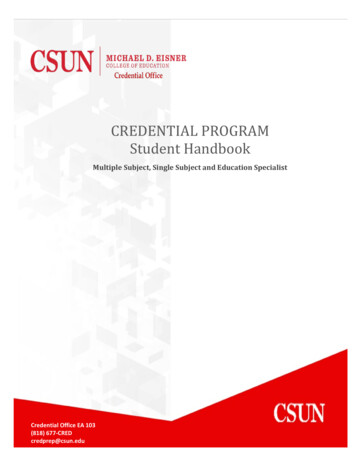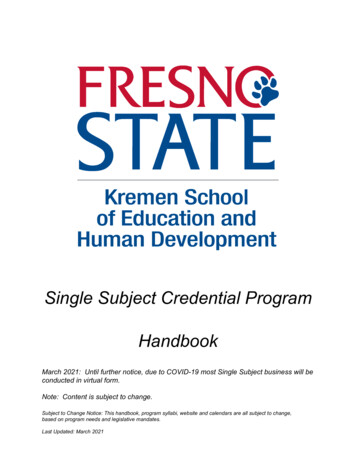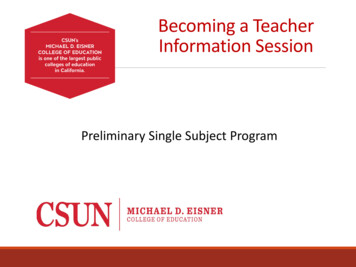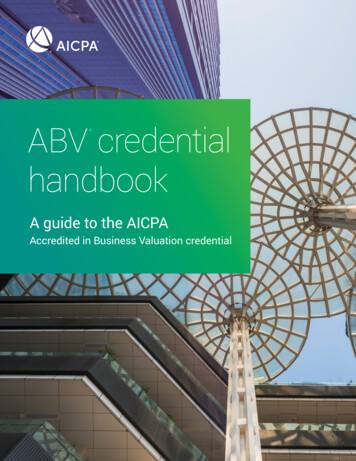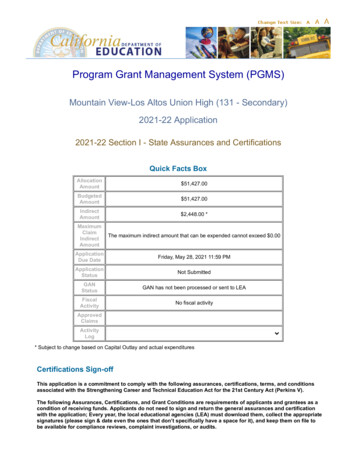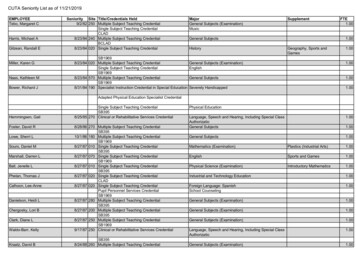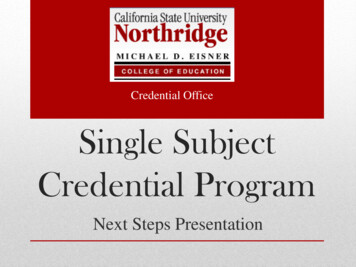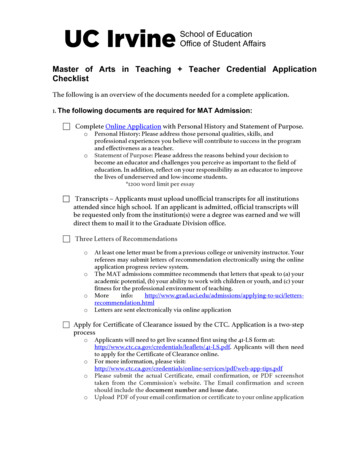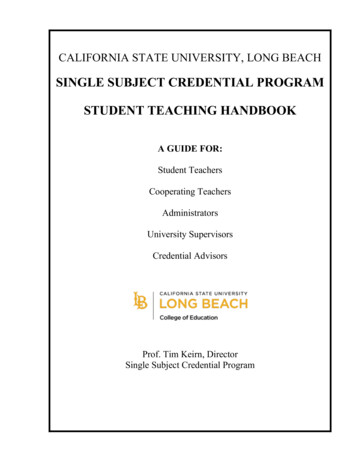
Transcription
CALIFORNIA STATE UNIVERSITY, LONG BEACHSINGLE SUBJECT CREDENTIAL PROGRAMSTUDENT TEACHING HANDBOOKA GUIDE FOR:Student TeachersCooperating TeachersAdministratorsUniversity SupervisorsCredential AdvisorsProf. Tim Keirn, DirectorSingle Subject Credential Program
California State University, Long Beach, Single Subject Credential ProgramStudent Teaching HandbookVision & Mission StatementCollege Vision:Equity & Excellence in EducationCollege Mission:The College of Education at CSULB is a learning and teaching community that prepares professionaleducators and practitioners who promote equity and excellence in diverse urban settings througheffective pedagogy, evidence-based practices, collaboration, leadership, innovation, scholarship, andadvocacy.Rev. January 2019Equity & Excellence in Educationi
California State University, Long Beach, Single Subject Credential ProgramStudent Teaching HandbookCalifornia State University, Long BeachSingle Subject Credential Program MissionStatementThe mission of the Single Subject Credential Programat California State University, Long Beachis to: Prepare effective and successful teachers for the California public schools who (a)are reflective and deliberative practitioners, (b) have mastered the content of theirdiscipline, and (c) are able to link content and pedagogy; Integrate research, theory, and best educational practice in the preparation ofteachers; Recruit and retain a culturally diverse student population; Provide professional and career advisement for students in the program; and Monitor and modify the quality of the program to address the changing needs of adiverse public school community.The Single Subject Credential Program at California State University, Long Beach has been approvedby the California Commission on Teacher Credentialing. As required by the Commission, theprogram periodically reviews the roles and evidence of fulfillment thereof of all participants in theprogram.Rev. January 2019Equity & Excellence in Educationii
California State University, Long Beach, Single Subject Credential ProgramStudent Teaching HandbookFOREWORDThe importance of student teaching cannot be overemphasized. Many teacher candidates reportthat student teaching is the most valuable phase of their teacher preparation. Student teaching providesan opportunity for application of subject matter knowledge and pedagogical knowledge to actualclassroom situations. Student teaching is the arena in which the pre-service teacher brings theory andpractice together in a sheltered learning environment under the mentorship of an experiencedCooperating Teacher and with the nurturing support of a University Supervisor.The purpose of this handbook is to provide direction for the student teaching semester to StudentTeachers, Cooperating Teachers, site administrators, and University Supervisors. Each member of thestudent teaching team contributes significantly to the student teaching experience; each hasresponsibilities to the other members of the team, to students, and to the teaching profession. Theinformation, guidelines, and suggestions in this Handbook will facilitate a successful student teachingexperience for each team member. To that end, Student Teachers, Cooperating Teachers, siteadministrators, and University Supervisors should be familiar with all sections of the Handbook. Theguidelines in this Handbook are “generic.” Each of the nine subject matter programs may haveadditional requirements, assignments, or expectations for their Student Teachers that are not addressedhere.Although the term “Student Teacher” is used throughout this Handbook to refer to programcandidates completing their culminating field experience, the guidelines and requirements similarlyapply to university interns using their contract position for “student teaching,” and who are alsoemployed by cooperating school districts. In addition to the common Application to Student Teachingthat all candidates for advancement to student teaching must submit, intern candidates must adhere tospecific guidelines and submit additional information (available in the Single Subject CredentialProgram office) ensuring the support of the school district they are employed in.The Single Subject Credential Program greatly appreciates the partnership of area schools andCooperating Teachers, who provide clinical settings for program students to complete their professionalpreparation.Contributions to the creation and ongoing development of this Handbook have been made bySingle Subject Credential Program faculty, members of the program Advisory Council, CooperatingTeachers, and the office staff.Questions, comments, and requests for clarification should be directed to the subject areacoordinator.Rev. January 2019Equity & Excellence in Educationiii
California State University, Long Beach, Single Subject Credential ProgramStudent Teaching HandbookSINGLE SUBJECT CREDENTIALPROGRAM DIRECTORYOFFICETELEPHONEDean, College of EducationDr. Shireen PavriEED-05(562) 985-4513Prof. Tim KeirnDirectorEED-61(562) 985-5642Single Subject Credential Program OfficeHellen Carcamo, Administrative CoordinatorEED-65(562) 985-7622Teacher Preparation Advising CenterJessica Olague, Assistant DirectorElodia Montano, Student Services Professional/AdvisorSheina Vogt, Student Services Coordinator/AdvisorAmber Thomas, TPAC Office CoordinatorEED-67EED-64EED-67EED-67EED-67(562) 985-1105(562) 985-1765(562) 985-4577(562) 985-5326(562) 985-1105Credential CenterKit Van Wyk, DirectorEED-42(562) 985-4109Career Development CenterBH-250(562) 985-4151OFFICETELEPHONESINGLE SUBJECT DISCIPLINECREDENTIAL ADVISORArtDr. Laurie GatlinFA2-201(562) 985-4385EnglishKathleen KeirnMHB-311(562) 985-4215Foreign Language (LOTE)Cynthia LeathersAS-317(562) 985-2200Health ScienceVikki BisorcaHHS2-119(562) 985-8083MathematicsDr. Josh CheslerFO3-109(562) 985-1554MusicDr. Tamara ThiesUMC-C209Email PreferredPhysical EducationDr. Emyr WilliamsHHS2-207(562) 985-7344ScienceKristin StraitsHSCI-218(562) 985-5949History/Social ScienceGail HamiltonFO2-117(562) 985-4428Rev. January 2019Equity & Excellence in Educationiv
California State University, Long Beach, Single Subject Credential ProgramStudent Teaching HandbookTable of ContentsCollege of Education Vision & Mission Statement . iSingle Subject Credential Program Mission Statement . iiFOREWORD . iiiSINGLE SUBJECT CREDENTIAL PROGRAM DIRECTORY . ivSection 1: Overview of Student Teaching . 1Course Enrollment for Student Teaching . 1Credential Recommendation . 1Student Teaching Assignment. 2Support Team . 3Tips for a Successful Student Teaching Experience. 3What to Expect from Student Teaching . 4Section 2: Responsibilities of the Student Teacher . 5Student Teacher Evaluations . 5Responsibilities as a University Student . 6Withdrawing from Student Teaching . 11Re-Entering Student Teaching after Withdrawing . 13Taking Courses Concurrent with Student Teaching . 14Early Dismissal . 14Substitute Teaching While Student Teaching . 14Section 3: Responsibilities of the Cooperating Teacher . 16Orientation: Preparing for the Student Teacher . 17Assessment and Evaluation Responsibilities . 21Section 4: Responsibilities of the Principal . 24Section 5: Responsibilities of the University Supervisor . 26Observation and Conference . 26Assessment and Evaluation. 27Working with a Struggling Student Teacher. 28Incomplete in EDSS 472A, B or C . 29Responsibilities to the University . 30Section 6: The Credential Center . 32APPENDIX A: MINIMUM EXPECTATIONS FOR STUDENT TEACHING . 33APPENDIX B: STUDENT TEACHER SELF-ASSESSMENT . 35APPENDIX C: STUDENT TEACHING ORIENTATION CHECKLIST. 38APPENDIX D: STUDENT TEACHING OBSERVATION & PARTICIPATION LOG . 39APPENDIX E: UNIVERSITY SUPERVISOR OBSERVATION FEEDBACK FORM . 42APPENDIX F: STUDENT TEACHING EVALUATION . 43APPENDIX G: SUBJECT SPECIFIC PEDAGOGIES EVALUATION CRITERIA . 48APPENDIX H: MID-TERM ACTION PLAN . 51APPENDIX I: FINAL EVALUATION INDUCTION PLAN . 52APPENDIX J:SEXUAL HARASSMENT AND STATEMENT ON CIVILITY & ACTS OFVIOLENCE . 53Appendix K: LIABILITY & WORKER’S COMPENSATION INSURANCE . 55Rev. January 2019Equity & Excellence in Educationv
California State University, Long Beach, Single Subject Credential ProgramStudent Teaching HandbookSection 1Overview of Student TeachingThe guidelines and requirements described in this handbook apply to all candidates who have advancedto student teaching: traditional student teachers and interns (modifications made as needed).Course Enrollment for Student Teaching1. Student teaching is offered through the courses EDSS 472A, B, and C (EDSS 572A, B, and Cfor interns) taken for credit or no-credit. Students must enroll in all three sections of the course.Each section carries 5 units of credit for a total of 15 units of student teaching. All sectionsmust be successfully completed for the Student Teacher to receive full credit for his or herstudent teaching and be recommended for a credential.Student Teachers who voluntarily withdraw for health, financial, or personal reasons prior tothe beginning of student teaching must reapply to student teaching for a future semester. Forinformation on withdrawing from student teaching see page 12.2. Student Teachers must also enroll in and attend EDSS 473, a subject specific Student TeachingSeminar. This course is taken as a co-requisite with student teaching (EDSS 472 A, B, C orEDSS 572 A, B, C) and is worth 3 units of credit.The seminar is traditionally graded (A, B, C, D, F) and students must receive a grade of C orbetter (maintaining a 3.0 GPA in program coursework) to be recommended for a credential.Therefore, during the student teaching semester students will be earning 18 units toward theircredential. The seminar is designed to assist the Student Teacher to:a. Solve instructional problems that may arise in the classroom.b. Provide a support group comprised of Student Teachers and his/her peers.c. Encourage the development of a professional attitude that is reflective and centered on theStudent Teacher’s growth and development as a teacher.d. Introduce and support students in the submission of Instructional Cycle 1 and Cycle 2 of theCalTPA.Credential RecommendationThe following must be fulfilled by the Student Teacher to be recommended for a teaching credential:1. The student must maintain an overall ‘B’ average in all EDSS and EDSE courses, including thestudent teaching seminar.Rev. August 2019Equity & Excellence in Education1
California State University, Long Beach, Single Subject Credential ProgramStudent Teaching Handbook2. A student may not receive a grade lower than a ‘C’ in the Student Teaching seminar (EDSS473).3. Students must successfully complete Instructional Cycles 1 and 2 of the CalTPA.4. Cooperating Teachers and University Supervisors must submit both the midterm and finalstudent teaching evaluations on S4 @ The Beach. Once these are submitted on S4 @ The Beachthey will be electronically transmitted to the Teacher Preparation Advising Center (TPAC)office. Students do not need to submit a hard copy.5. Students must receive CR in EDSS 472A, EDSS 472B and EDSS 472C or EDSS 572A, EDSS572B and EDSS 572C. Students who receive a ‘No-Credit’ grade in one or two 5-unit sections of student teachingmay petition to re-enter student teaching in the future with the support of the subject areacoordinator. They will be asked to demonstrate successful remediation of observedweakness before re-entry is approved.6. Students must file a Request for Recommendation with the Credential Center (EED-42) uponcompletion of student teaching and passage Instructional Cycles 1 and 2 of the TPA.Student Teaching AssignmentStudent teaching assignments are made through the cooperative efforts of the Subject Area Coordinator,SSCP Director, district administrator, school site administrator, and Cooperating Teacher. StudentTeachers are not permitted to arrange their own student teaching assignments. Student Teachers areassigned to local schools that have agreements in place with the university as part of the teacher trainingprocess. Several factors are used in assigning Student Teachers to specific schools.1. The assignment must be appropriate in terms of the subject.2. Approved and credentialed Cooperating Teachers must be available. The cooperating teachermust hold a clear credential in the same authorization area in which the student teacher isseeking certification.3. The location of the school must be within the CSULB service area (a 20-mile radius fromCSULB). Some subject area programs will place students beyond this radius on a case-by-casebasis.4. Each placement must provide the student teacher the opportunity to demonstrate the ability toteach and promote learning with students from diverse social, cultural and economicbackgrounds.5. Student Teachers are responsible for 20 weeks of student teaching. Student Teachers assumecomplete responsibility for three periods of student teaching. Student Teachers are alsoresponsible for one additional period for observation and one additional period for preparation.Rev. August 2019Equity & Excellence in Education2
California State University, Long Beach, Single Subject Credential ProgramStudent Teaching HandbookNormally, to meet this five-class obligation, student teachers should expect to be on campus aminimum of 25 hours a week.Support TeamThe program provides Student Teachers with two or more highly qualified, well skilled and experiencedteacher educators in the form of a University Supervisor and Cooperating Teacher(s).The Cooperating Teacher(s): CSULB requires the following minimum qualifications for CooperatingTeachers:a.hold a Clear Credential in the same subject area as the Student Teacher or equivalent,b.be tenured in their district or have a minimum of three years successful teaching experience,andc.have a strong interest in mentoring Student Teachers.In addition, they should be recognized as outstanding teachers who are knowledgeable in their subjectand skilled in pedagogy.The Cooperating Teacher will be on campus and in the classroom daily with the Student Teacher, butwill provide opportunities for “solo” teaching as appropriate. In most instances, Student Teachers willwork with more than one Cooperating Teacher.The University Supervisor: University Supervisors are faculty members at CSULB. UniversitySupervisors have the following qualifications:a.at least three years K-12 teaching experience (public or private).b.hold or have previously held a Clear Single Subject Credential in the subject area theysupervise, or equivalent.c.contemporary professional experiences in school settings at the levels that they supervise.University Supervisors serve as a liaison between the placement school of the Student Teacher and theSSCP. The University Supervisor will make at least ten campus visits with a minimum of six formalobservations – three of which are to take place prior to the midterm with one in each of the three periodsassigned to the student teacher.Tips for a Successful Student Teaching Experience Each member of the triad (Student Teacher-Cooperating Teacher-University Supervisor) shouldwork to build and maintain a harmonious and professional team. Student Teachers should be forthright in discussing strengths and weaknesses, areas of confidenceand areas of anxiety, expectations and fears, with their respective teams. Keep in mind that theCooperating Teacher and University Supervisor will be of greater assistance if the Student Teacheris open, flexible, able to accept constructive feedback, and willing to take risks to extend his/herteaching repertoire.Rev. August 2019Equity & Excellence in Education3
California State University, Long Beach, Single Subject Credential ProgramStudent Teaching Handbook Student Teachers should arrive at their placement sites well before the start of the school day andstay until well after it ends each day in order to experience the school’s culture. For the same reason,Student Teachers should attend and volunteer to supervise school events, as appropriate. Student Teachers are expected to attend all meetings of the student teaching seminar course (EDSS473) Student Teachers should dress and behave professionally. Student Teachers should learn and use all students’ names as early in the semester as possible. Student Teachers should be courteous to all school staff.What to Expect from Student Teachingv In consultation with the Cooperating Teachers and University Supervisors, and appropriate tospecific district policies concerning student teaching practices (for example co-teaching andgradual release of responsibility models), the Student Teacher assumes classroomresponsibilities at a pace consistent with his/her developmental readiness.v The other two periods of the Student Teacher’s day are for preparation, observation, andconsultation. During this time Student Teachers engage in a variety of activities, which includeteaching informally or assisting the Cooperating Teacher, observing other classes (includingclasses outside the Student Teacher’s subject area), preparing lesson plans and materials,reading, assessing, and correcting student work, assisting with school activities, andconferencing with the Cooperating Teacher and the University Supervisor.v Student Teachers should note that the university calendar may not coincide with the districtcalendar. Student Teachers are required to follow the calendar at his/her teaching site and areexpected to finish the entire term. CSULB’s university calendar may not coincide with thedistrict calendar, i.e., student teaching begins and ends when the placement school begins andends its term without regard for CSULB’s vacation periods. Student Teachers must completea full 20 weeks of student teaching.v School personnel should be aware that Student Teachers still have responsibilities to theuniversity. Allowances should be given to the Student Teacher to fulfill such obligations.Student Teachers will need to be released from teaching responsibilities to attend the StudentTeacher Professional Day. The date and time for this event will be publicized early in thesemester allowing the Student Teacher ample time to prepare for the Cooperating Teacher totake over for that day.v Unauthorized withdrawal from student teaching assignments may result in a grade of no-credit(NC) for EDSS 472 and F for EDSS 473 (see SSCP Policy 11).v Depending on the school district, the CSULB semester may end approximately four weeks priorto the student teaching semester. Due to this schedule, it may be necessary to assign a StudentTeacher an INC in all or part of student teaching to allow the University Supervisor additionaltime to assess if the Student Teacher has successfully completed student teaching.Rev. August 2019Equity & Excellence in Education4
California State University, Long Beach, Single Subject Credential ProgramStudent Teaching HandbookSection 2Responsibilities of the Student TeacherStudent teaching is the most important experience in your professional preparation. University andschool personnel work as a support team to assist in your success. Your team is there to ensure thatyou: Learn and understand your role as a teacher.Develop your potential as a teacher.Keep in mind that during your student teaching experience, you are both a university student and ateacher in your assigned school. You are a student in terms of your relationship to CSULB, your Cooperating Teacher and yourUniversity Supervisor. You are a teacher to your students, their parents, your principal, and other school personnel.As a Student Teacher you represent CSULB and the SSCP in your respective placement school.You are expected to work and act in a professional manner that reflects well upon yourself, thecredential program, and the university. Student Teachers who act in an unprofessional manner maybe withdrawn from the assignment and receive a grade of no-credit (NC) for one or more of thestudent teaching courses (EDSS 472A,B,C or EDSS 572A,B,C).Ø All Student Teachers must adhere to California’s legal requirements for teachers, as well as thepolicies, rules and regulations of the university and the placement school.Student Teacher Evaluations1. Both the mid-term and final evaluations are done on S4 @ The Beach. You should familiarizeyourself with the evaluation (see Appendix G) prior to the start of the semester so that youunderstand the assessment criteria. The performance areas and indicators on the evaluation form are closely linked to the CaliforniaTeaching Performance Expectations. These standards are used to develop pre-service programs(such as this one), form the foundation for beginning teacher induction programs throughoutCalifornia, and are the measure of good beginning and veteran teachers.Mid-term evaluations must be submitted via S4 @ The Beach by November 15th for fall studentteaching and April 15th for spring student teaching. Final Evaluations must be submitted via S4@ The Beach by January 10th for fall student teaching and by June 10th for spring studentteaching.The evaluation of your student teaching will be done from the perspective of you as a noviceteacher. You will not be expected to perform these standards at the level of an experiencedclassroom teacher.Rev. August 2019Equity & Excellence in Education5
California State University, Long Beach, Single Subject Credential ProgramStudent Teaching Handbook2. Though you will be evaluated as a novice teacher based on your teaching performance, both yourCooperating Teacher and your University Supervisor will consider yourpotential as a prospective teacher. You will be expected to perform at a level of competence thatwill allow the program to confidently recommend you for your initial teaching credential.3. A self-assessment tool is provided in Appendix B. You should refer to this regularly as a way ofassessing your growth and development over the course of the semester.4. Mid-term and final evaluations must submitted via S4 @ The Beach by both your UniversitySupervisor and Cooperating Teacher(s). You will conference with your University Supervisor andCooperating Teachers to review and discuss the evaluations.5. The mid-term evaluation is for formative purposes and does not leave the TPAC Office.6. At the midterm, the university supervisor in consultation with your cooperating teachers willgenerate an Action Plan that will specify the next steps needed to demonstrate improvement orcontinued growth by the end of your semester at the school site. This will also be uploaded to S4@ The Beach.7. The final evaluation is summative and remains in the TPAC office and is normally requested in allemployment applications for teaching positions. In addition, the university supervisor inconsultation with your cooperating teachers will generate an Induction Plan that will providerecommendations for professional development and growth in your clear credential program. AnInduction Plan is required by the California Commission on Teacher Credentialing (CTC) for allpreliminary credentialed teachers.8. You are responsible for printing a copy from S4 @ The Beach for use when applying for teachingpositions and for your teacher induction program during your first two years of teaching.Responsibilities as a University StudentBelow is a list of responsibilities you must fulfill in order to complete student teaching successfully:A. Follow the policies of the university and your subject area department.B. Attend scheduled meetings on campus, including the Student Teaching Seminar (EDSS 473)and Student Teacher Professional Day.C. Read the EDSS 473 syllabus and the Student Teaching Handbook carefully, and adhere to allrequirements and policies.D. Meet all deadlines including submission of your mid-term and final evaluation, action andinduction plans,E. Respond to email and phone messages from your University Supervisor, CooperatingTeachers, and CSULB Faculty and Staff.Rev. August 2019Equity & Excellence in Education6
California State University, Long Beach, Single Subject Credential ProgramStudent Teaching HandbookF. Ensure that your University Supervisor and Cooperating Teacher(s) submit your mid-termevaluations on S4 @ The Beach by November 15 for fall semester student teaching and April15 for spring semester student teaching.G. Ensure that your University Supervisor and Cooperating Teacher(s) submit your finalevaluations on S4 @ The Beach by January 10 for fall semester student teaching and June 10for spring semester student teaching.H. Make and keep appropriate conference appointments with your University Supervisor.I. Inform the TPAC Office, the Credential Center, and University Enrollment Services of changesin your name, address, e-mail, or telephone number.J. Follow the school’s procedures in the case of an accident or injury and report the informationto the TPAC Office (See Appendix K).K. Report immediately to the TPAC Office (562/985-1105) in the event of a strike of certificatedemployees in the school district. Do not appear at your assigned school. Student teachers areto abide by all collective bargaining agreements.Orientation to the School and ClassroomInitial orientation occurs when you meet with your Cooperating Teacher to observe his or her classes.You will discuss which classes you will take responsibility for, and devise a schedule for assumingresponsibility for classes.Once your placement is confirmed, contact your Cooperating Teacher and arrange to do the following: Observe and assist; become familiar with practices, procedures, classroom routines,management/discipline policies, goals, objectives, and expectations. With your Cooperating Teacher’s assistance, study the scope and sequence of courses to be taughtso that you can make a long-range plan for the semester’s instruction. Obtain copies of district and/or departmental curriculum standards, as well as your personal copiesof
California State University, Long Beach, Single Subject Credential Program Student Teaching Handbook Equity & Excellence in Education Rev. January 2019 iii iii FOREWORD The importance of student teaching cannot be overemphasized. Many teacher candidates report that student teaching is the most valuable phase of their teacher preparation.
